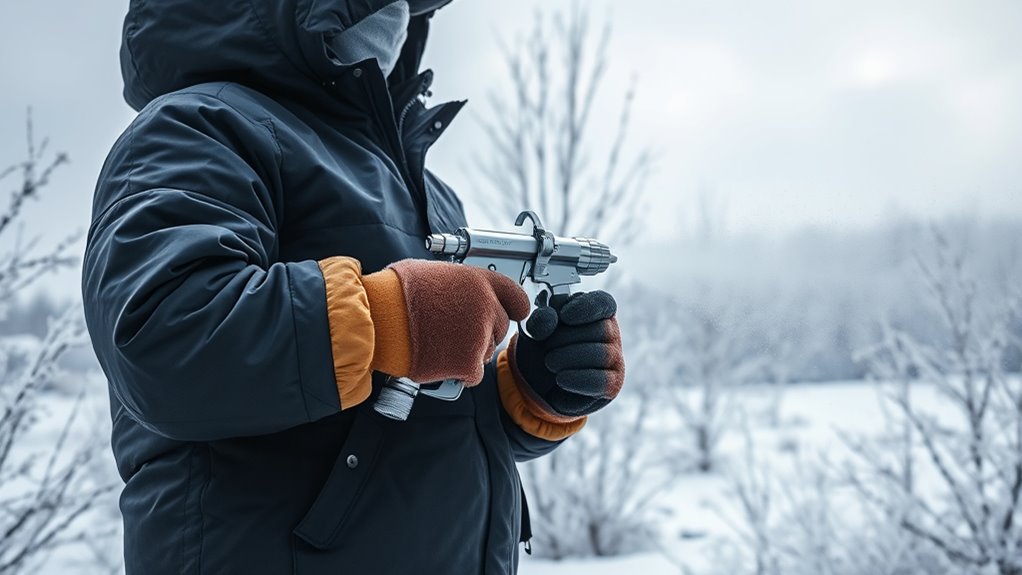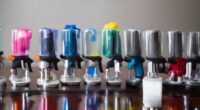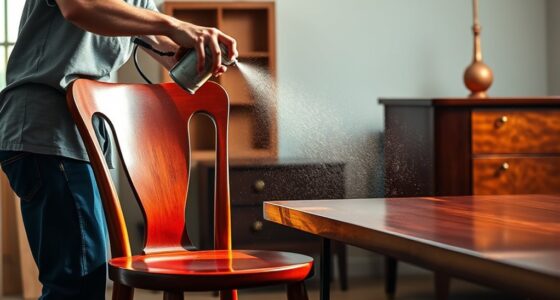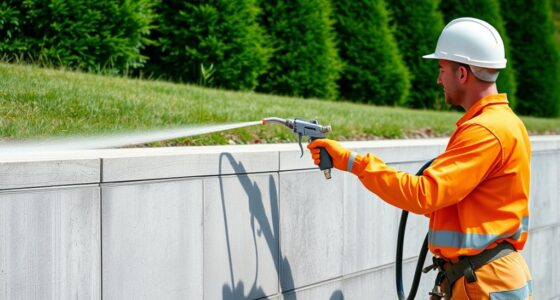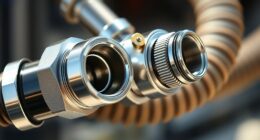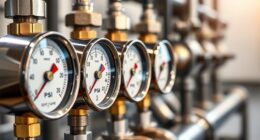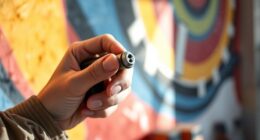Painting in cold weather can be tricky, but with the right approach, you’ll get great results. Use paints formulated for low temperatures, keep your workspace warm, and prepare surfaces thoroughly. Adjust your spray equipment for colder conditions, and dry coats with heaters or fans to speed up drying times. Maintain safety precautions and guarantee proper ventilation. If you want to master cold weather spraying techniques and avoid common pitfalls, stay with us for more expert tips.
Key Takeaways
- Use cold-weather compatible paints and primers designed for low temperatures to ensure proper adhesion and drying.
- Keep surfaces and materials warm and dry; utilize portable heaters or climate control solutions during application.
- Properly calibrate spray equipment and use nozzles suited for cold conditions to ensure even coverage.
- Thin paints and use additives if necessary to improve flow and drying times in low temperatures.
- Maintain safety by wearing PPE, ensuring proper ventilation, and avoiding painting in extreme cold or windy weather.
Understanding How Cold Temperatures Affect Paint Performance

Cold temperatures can considerably impact how paint performs, often making it difficult to achieve a smooth, even finish. When painting in low temperatures, the paint film formation slows down, which can lead to uneven coverage and poor adhesion. One key factor is solvent evaporation; colder air reduces the rate at which solvents escape from the paint. This slow evaporation causes the paint to stay wet longer, increasing the risk of runs or drips. Additionally, it can result in a tacky or soft finish that takes longer to cure. If you don’t account for these effects, your project may not meet your expectations. Understanding how cold affects solvent evaporation and film formation helps you plan your application better, ensuring a more durable and professional-looking result. Temperature’s effect on curing is an important aspect to consider for optimal results.
Furthermore, awareness of paint formulation differences can help you choose the right product for low-temperature conditions.
Choosing the Right Paint for Cold Weather Application
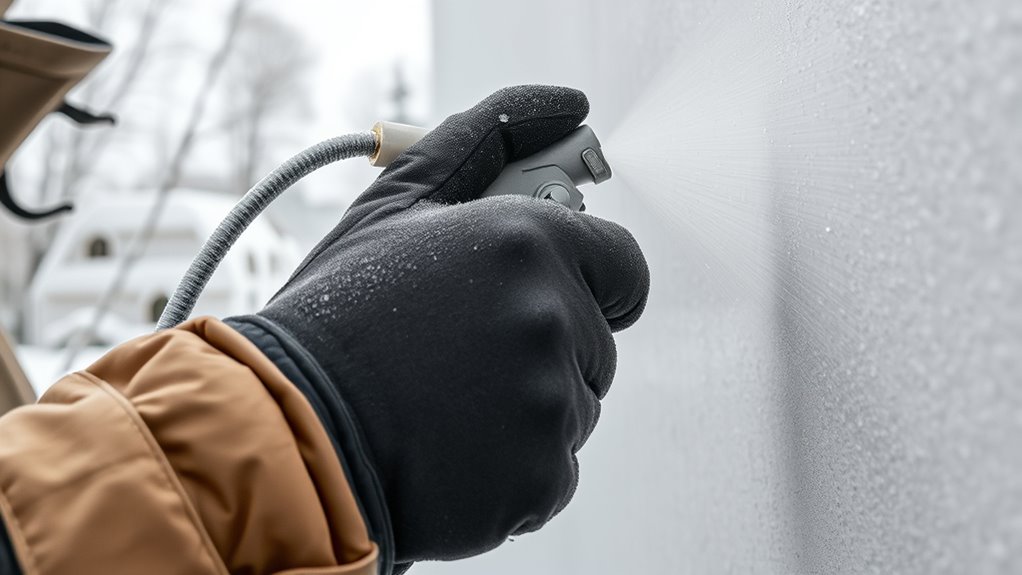
When selecting paint for cold weather, you need formulas designed to perform well in low temperatures. Look for options that are specifically labeled as cold-weather compatible and dry quickly to avoid delays. Choosing the right type guarantees better adhesion and a smoother finish despite the chilly conditions.
Cold-Weather Compatible Formulas
Choosing the right paint formula is essential for successful cold-weather applications, as not all paints perform well under low temperatures. You need to select formulas that are specifically designed to be temperature sensitive, ensuring proper curing and adhesion despite the cold. Cold-weather compatible formulas are formulated to maintain their workability and durability when applied in low temperatures, preventing issues like cracking or poor adhesion. Check the product specifications for temperature range and formula compatibility with cold conditions. Using the right formula means you won’t have to worry about unexpected failures or rework later. Always opt for paints labeled for cold weather use, and follow manufacturer recommendations to guarantee ideal results. Proper selection ensures your project withstands the challenges of low-temperature environments. Additionally, understanding the temperature-sensitive formulation of paints can help you choose products that are optimized for cold weather, ensuring a smoother application process and longer-lasting finish. Being aware of formulation stability under different temperature conditions can also contribute to better project outcomes. To further enhance your results, consider the application techniques suitable for low temperatures to ensure even coverage and proper drying. Incorporating environmental considerations such as minimizing environmental impact can also be beneficial when planning your cold-weather painting project. Moreover, selecting paints with advanced polymer technology can improve flexibility and adhesion in cold conditions, reducing the risk of peeling or cracking over time.
Fast-Drying Options
Fast-drying paints are essential for cold-weather applications because they help you complete projects efficiently and reduce exposure to low temperatures that can hinder curing. When choosing the right paint, look for quick drying formulas that minimize wait times and improve productivity. These fast curing paints are designed to set rapidly, even in low temperatures, ensuring a durable finish. To optimize your results, consider: 1. Selecting fast curing paints formulated specifically for cold weather. 2. Using spray products labeled as quick drying formulas for faster application. 3. Combining fast-drying options with proper surface preparation to enhance adhesion and longevity. Additionally, choosing paints with advanced filtration technology can help ensure better coverage and reduce airborne particles during application.
Preparing Your Workspace and Materials for Low-Temperature Painting
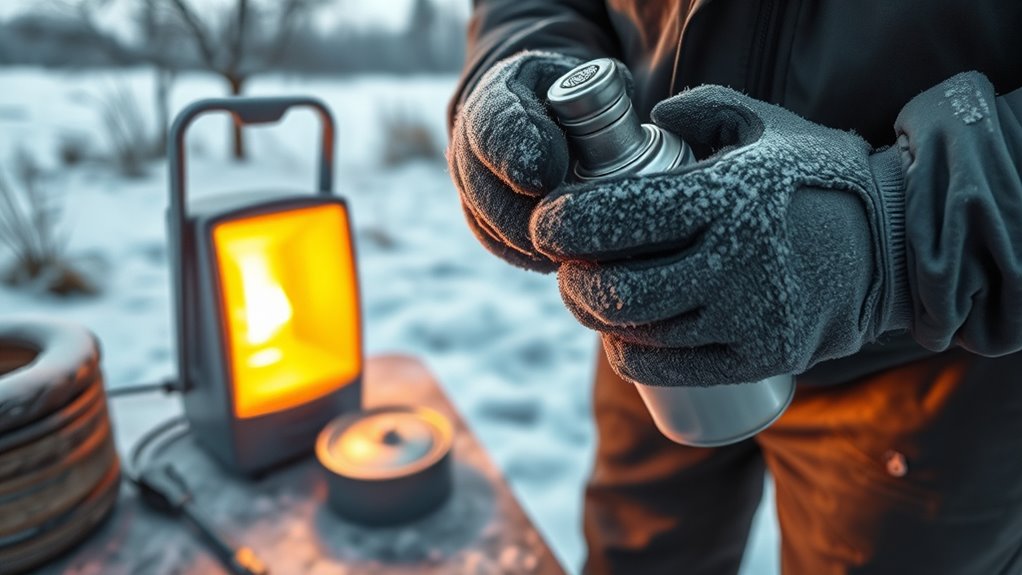
Before you start spraying, make sure your equipment is properly checked and calibrated for cold temperatures. Properly store and handle your paint to prevent it from thickening or freezing. Taking these steps helps guarantee a smooth, effective painting process in chilly conditions. Additionally, maintaining appropriate paint temperature ensures optimal flow and adhesion during application. Using a paint thermometer can help monitor and maintain the correct temperature for best results. Be mindful that spoiled lemon juice or improperly stored paint can lead to inconsistent spraying performance. To further ensure quality, consider using paint additives designed for low-temperature application to improve flow and drying times. Regularly inspecting your tools for clogged nozzles can also prevent uneven spray patterns caused by cold weather.
Equipment Check and Calibration
As you prepare to paint in cold weather, it’s essential to thoroughly check and calibrate your equipment to guarantee peak performance. Proper sprayer maintenance ensures consistent spray patterns and prevents clogs caused by low temperatures. Start by inspecting hoses, filters, and seals for cracks or blockages. Next, calibrate your sprayer to adjust pressure and flow rate, accounting for the paint’s viscosity in cold conditions. Pay special attention to nozzle selection; choose nozzles designed for low-temperature application to achieve a smooth, even coating. Additionally, understanding the best airless paint sprayers can help you select equipment specifically suited for cold-weather use. Regular maintenance and proper calibration are crucial because tuning ensures your equipment functions optimally in challenging conditions, preventing issues like uneven spray or equipment failure. To further improve your results, consider temperature management strategies to maintain optimal paint flow and application consistency in low temperatures, especially since professional-grade equipment often offers better performance in adverse weather conditions.
Material Storage and Handling
Ensuring your materials are properly stored and handled is vital when painting in cold weather. Proper material storage prevents freezing and maintains paint quality. Store your paint, primers, and solvents in a warm, dry place, ideally above 50°F, to keep them from thickening or solidifying. Avoid exposing materials to freezing temperatures overnight. When handling your materials, use proper handling techniques by wearing gloves and using clean tools to prevent contamination. Keep lids tightly sealed to prevent moisture ingress, which can cause clumping or spoilage. Before use, gently warm cold materials to room temperature to guarantee smooth application. Checking your materials regularly for signs of spoilage or thickening is essential to ensure consistent application and a high-quality finish. Additionally, understanding the effects of low temperatures on paint can help you make informed decisions about application techniques and drying times. Being aware of paint formulation differences can assist in selecting the right products suited for low-temperature environments. Recognizing the impact of low temperatures on drying times is crucial for planning your work and ensuring a durable finish. Proper storage and handling are essential for achieving a consistent finish and avoiding costly mistakes caused by low-temperature effects on your materials. Incorporating climate control solutions such as portable heaters or enclosed workspaces can also help maintain optimal conditions for painting in cold weather.
Tips for Proper Surface Preparation in Cold Conditions

Cold weather can critically impact surface preparation, so it’s vital to adapt your techniques accordingly. Start by thoroughly cleaning the surface to remove dirt, grease, and moisture; cold conditions can trap moisture, leading to poor adhesion. Next, guarantee the surface is dry before applying primer—moisture hampers proper bonding. Use warm water or mild cleaners to facilitate surface cleaning, and consider gentle scraping or sanding to smooth rough areas. When applying primer, select a cold-weather primer designed for low temperatures, and allow adequate drying time. Keep the surface warm during preparation, if possible, to prevent moisture condensation. Proper surface cleaning and primer application set the foundation for a durable, high-quality paint job in cold conditions. Additionally, using self watering plant pots or similar tools can help maintain consistent moisture levels, which may be beneficial in colder climates where moisture control is more challenging. Ensuring proper surface preparation is essential, as neglecting it can lead to adhesion problems and reduce the longevity of your paint job. Incorporating skincare ingredients like glycolic acid into your routine before painting can also help improve skin resilience against harsh conditions.
Techniques for Effective Spraying in Low Temperatures

Painting in low temperatures requires adjusting your spraying techniques to achieve a smooth, even finish. Start by maintaining a consistent distance between the spray gun and the surface to prevent uneven coverage. Use steady, overlapping spray patterns to ensure uniformity and avoid streaks. When applying paint, keep your brush techniques smooth and controlled, especially if you switch to brushing for touch-ups, to prevent lap marks. Adjust your spray pattern to a narrower setting if the paint tends to run or drip, which is common in cold conditions. Keep your movements deliberate and even, and avoid rushing the process. Properly controlling your spray patterns and brush techniques helps counteract the slower drying times and ensures a professional-looking result despite the low temperatures.
Managing Drying and Curing Times When It’s Cold
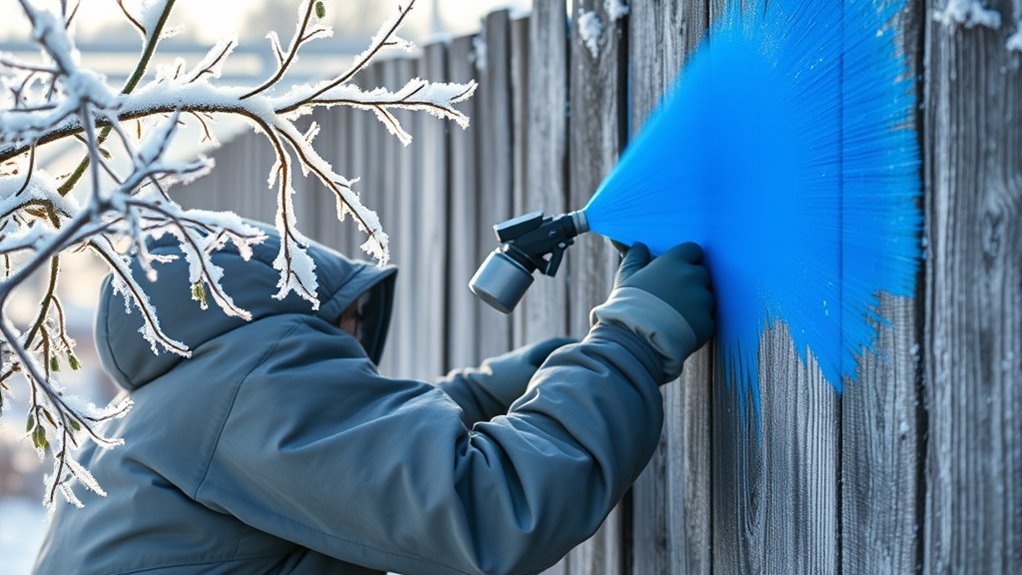
When temperatures drop, drying and curing times for paint naturally slow down, making it essential to adjust your expectations and techniques. To manage this, focus on temperature regulation by maintaining a consistent environment and avoiding sudden temperature fluctuations. You can also use drying acceleration techniques, such as applying thin coats and increasing air circulation.
Consider these strategies:
- Keep the workspace warm with heaters or heat lamps to promote consistent drying.
- Use fast-drying primers and paints designed for low temperatures to speed up curing.
- Increase airflow to facilitate moisture evaporation, but avoid direct drafts that could cause uneven drying.
Safety Precautions and Final Tips for Cold Weather Painting

Ensuring safety during cold weather painting is just as important as managing drying times. Always wear the appropriate personal protective equipment, including gloves, goggles, and masks, to protect yourself from fumes and splatters. Cold temperatures can cause paint fumes to linger longer, so ventilation considerations are vital—work in well-ventilated areas or use fans to improve airflow. Keep an eye on weather conditions, avoiding painting during extreme cold or wind that could compromise safety. Handle paints and solvents carefully, storing them properly to prevent spills or accidents. Finally, take regular breaks to stay warm and alert. Following these safety tips ensures your cold weather painting project proceeds smoothly and safely, protecting both your health and the quality of your work.
Frequently Asked Questions
How Can I Tell if the Paint Is Curing Properly in Cold Weather?
You can tell if the paint is curing properly by checking its film appearance and curing time indicators. Look for a smooth, even surface without tackiness or soft spots, which suggests good curing. Typically, the curing process takes longer in cold weather, so follow manufacturer guidelines for curing time. If the paint feels hard and looks consistent after the recommended period, it’s likely curing correctly and ready for use.
What Equipment Modifications Are Recommended for Cold Weather Spraying?
To optimize your cold weather spraying, you should consider equipment modifications like adding insulation to your spray equipment to maintain consistent temperature and prevent freezing. Integrate portable heaters or heat blankets to keep the paint and equipment warm during operation. These modifications help guarantee proper atomization and adhesion, allowing you to achieve a quality finish despite the low temperatures. Always monitor temperatures closely to prevent issues caused by cold conditions.
Can I Use Regular Paint Products in Sub-Freezing Temperatures?
You shouldn’t use regular paint products in sub-freezing temperatures because cold weather affects paint consistency and surface preparation. When temperatures drop below freezing, paint can thicken or freeze, making it difficult to apply smoothly and adhere properly. To guarantee a quality finish, opt for cold-weather or specialized paints designed for low temperatures, and always prepare the surface thoroughly for better adhesion and durability in chilly conditions.
How Does Humidity Impact Cold Weather Painting Projects?
Imagine the sky’s humidity effects on a storm, where moisture controls the outcome. In cold weather, high humidity can cause paint to dry slowly or form bubbles, just like storm clouds delaying rain. To avoid mishaps, you need moisture regulation by choosing the right time and conditions for painting. Properly managing humidity ensures your project dries evenly and adheres well, preventing future peeling or cracking.
What Are Common Mistakes to Avoid When Painting in Low Temperatures?
When painting in low temperatures, you should avoid common mistakes like ignoring temperature fluctuations that can affect paint adhesion and drying times. Don’t skip proper surface prep, as moisture and dirt can cause peeling or uneven finish. Make sure to check the weather forecast and plan your work for stable conditions. Rushing the process or using paint not suited for cold weather can also lead to poor results.
Conclusion
So, next time the thermometer drops, remember: cold weather painting isn’t just a test of patience—it’s a test of your ingenuity. With the right tips, you’ll master the art of spraying in freezing temps and impress everyone with your frost-proof finish. Who knew painting in the cold could be so thrilling? Just don’t forget your gloves, and maybe a hot cocoa—because even superheroes need a break from the icy battlefield. Happy painting!
A seasoned painter with over 15 years in the industry, Mike transitioned from hands-on painting projects to the digital world of paint sprayers. His extensive experience gives him a unique perspective on what users truly need when it comes to painting tools. As the Editor in Chief of Paint Sprayer Zone, Mike ensures that every piece of content not only provides value but also reflects the realities of painting — the challenges, the joys, and the intricate details.
